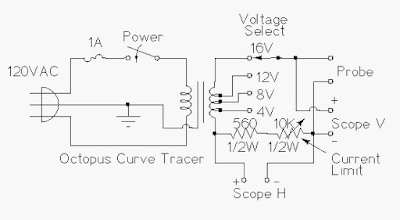This project involves the construction of a low-cost curve tracer that is suitable for testing a wide variety of electronic components both in-circuit and out of circuit. It is easy to construct and extremely useful for finding defective parts, especially semiconductors, in electronic devices.
The octopus is used in conjuction with an oscilloscope set to display in X-Y mode. It displays voltage across the test probes on one axis and current through the probes on the other axis. A scope with both Horizontal and Vertical inputs (X-Y mode) is required.
This is my version of a circuit that has been around since at least the 1960s, I added the ability to select voltage taps on the filament transformer and adjust the amount of current through the probes.
Octopus Curve Tracer Circuit Diagram
Theory:
Power is applied to the step-down transformer through a 1 amp fuse and a power switch. The transformer has output taps at 4V, 8V, 12V and 16V. If you can't find an equivalent transformer, a more common 6V/12V transformer will work. The voltage select switch allows one of four voltages to be selected. The current limit variable resistor selects the maximum current through the test probes.
When the probes are open, the scope will display a vertical line, when the scope probes are shorted, the scope will display a horizontal line. The octopus places a constantly changing sine wave voltage across the probed device. The horizontal axis shows the current through the probes and the vertical axis shows the voltage across the probes. As the sine wave changes, the scope trace loops around in accordance with the associated current and voltage readings from the probe. Probing different electronic components will produce a variety of unique scope patterns.
Construction:
The octopus was built into a deep 4"x4" electrical utility box, as shown in the photo. A tall lid was used for the top to make enough room for the transformer. The box knock-outs on the front were removed and the switches and potentiometer were mounted on an aluminum plate that was screwed into the side of the utility box.
The test jack holes were drilled directly into the box and the power and oscilloscope cables were secured to the box with common Romex cable clamps. The oscilloscope cables were made with flexible RG-58 coax pieces and terminated with BNC connectors for direct connection to the scope.
Use:
Connect the Horizontal and Vertical connectors to the oscilloscope inputs, power up the octopus and adjust the scope's vertical and horizontal amplifiers for full screen-width lines when the probes are open and shorted.
Place various components across the scope and adjust the voltage taps and current limiter for the best display. The 12V setting is a good default value.
Here are some typical curves that the octopus will display:
Open Circuit - vertical line
Short Circuit - horizontal line
Resistor - diagonal line, slope varies with the value
Capacitors and Inductors - ellipses, shape varies with value
Diodes - L shaped curve
Zener Diodes - squared Z shaped curve
Transistor EC - tall L shaped curve
Transistor EB - squared Z shaped curve
Transistor BC - L shaped curve (same as diode)
Varistor - S shaped curve
The octopus is especially good at finding defective semiconductor devices. Power transistors often short out when they fail. The octopus can quickly find shorted parts, even in circuit. Leaky transistors and diodes will have curves with rounded corners instead of right angles. Keep in mind that antique germanium transistors tend to show as leaky, even when they are perfectly good devices.
By placing the probes on a transistor's emitter and collector leads, then touching the base lead with your finger, you can observe the device's gain by seeing how much the curve changes.
In-circuit testing with the octopus is a bit of an acquired skill, a wide variety of curves can be found and faulty components can be identified. If suspicious components are found, they can be removed from the circuit and tested further.


No comments:
Post a Comment